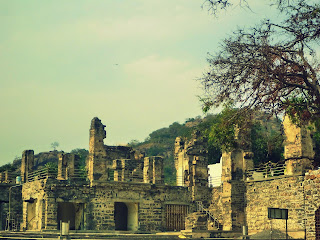What hit me upfront when I drove into Vijayawada was its complex network of lanes and by-lanes with its walls hand-painted in rich floral motifs and the generous tarred roads completely taken over by hordes of men and vehicles. It was late afternoon when I checked into Hotel Fortune Murali Park on MG Road. By the oh-so-familiar moniker of the street, I knew that I was in the quintessential centre of commerce and city living. Being a foodie with a thing or two for the tantalizing aroma of spices, I was looking forward to the gastronomic delights that awaited me in the second biggest city of Andhra Pradesh. Sweet Magic, a popular chain of restaurants with a fourteen-year legacy, has an outlet bang in the middle of MG Road. I walked across the street to sample the Ulavacharu Dosa, a local specialty made from horsegram lentils, and Ghee Pongal, the South’s answer to a soul-warming plate of khichdi. Both were served with an assortment of chutneys, sambar and beetroot rasam. With a grateful tummy, I rambled in tandem with the weekend reverie, occasionally stopping to take a good look at the saree heavens looming over me.
I started my tour of Vijayawada the next morning with a visit to Bhavani island, an islet formed by river Krishna, on the banks of which the city stands. The expanse assumed silvery tones of morning glory as it pushed the steamers towards the shore. Multiple flags of APTDC perched on the metal fencing proclaimed the ethereal beauty of the state as a mixed group of tourists and daily commuters occupied their seats on the boat. Life went on as usual for those getting their daily chores of washing and bathing done by the riverside. A reposeful calm filled my senses as they feasted on the slow breeze stroking the waters.
From island to forest, I pressed on in search of the lesser known jewels of a land that boasts of the historic Hazratbal mosque, Victoria Museum and the archaic caves of Undavalli. The quest led me on to Bommala Colony or Toys Colony, an unassuming village on the outskirts of the Kondapalli reserve forest that has an abundance of softwood trees known as Tella Poniki. The sight that hailed me in was that of artisans deeply engrossed in their craft of carving miniature representations of familiar local scenes, keeping a 400-year old tradition alive. Kondapalli toys have obtained geographical indication status from the government as a recognition and certification of its cultural roots. I bought some souvenirs from the craftsmen before proceeding to the fort lying on a forested hill to the west of the village. Constructed by the Musunuri Nayaks - warrior kings from the 14th century, Kondapalli fort passed hands before coming under the custody of the British East India Company who used it as a military training base. Mostly in ruins today, the site is reminiscent of the many battles it survived throughout the ages. I entered through the Dargah Darwaza and clicked away as young couples shared sweet nothings between the rickety stone pillars.
For my lunch-time indulgence, I chose the crowd favourite RR Durbar because it would have been a shame to leave the city without getting my hands on their dum biriyani. I spent the evening watching the sun disappearing in the mighty embrace of the Krishna as the majestic Prakasam Barrage stood sentry to the cacophony of traffic on one side and the tranquillity of the river on the other. Meanwhile, devotees thronged to the Kanaka Durga Temple situated atop the hills of Indrakeeladri beside the Krishna.
I ended the day with an overdose of Chilli Prawns and Natukodi Chicken (country chicken) from a popular haunt known as Rasoie. My taste-buds were deliriously overjoyed by the homey concoction of masala and herbs that everything until then was rendered ablur. If you were to ask what I love about Vijayawada, I’d simply say ‘Natukodi’ all the way!



























